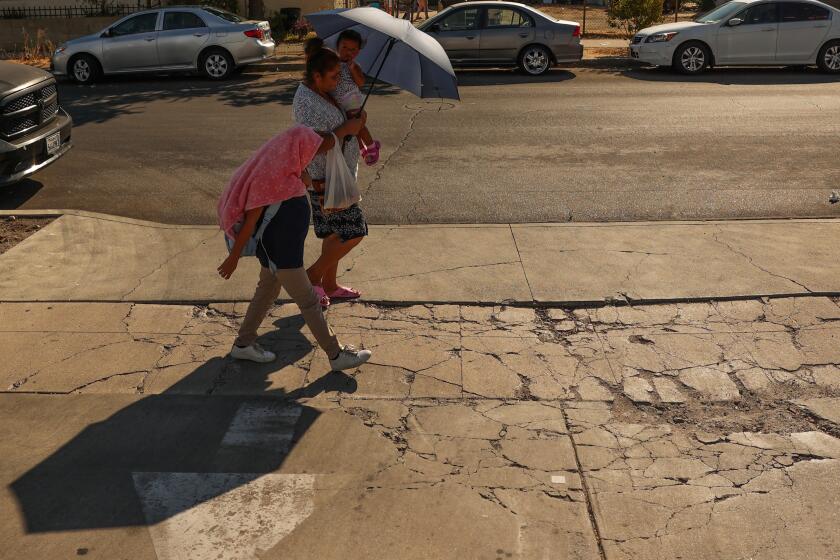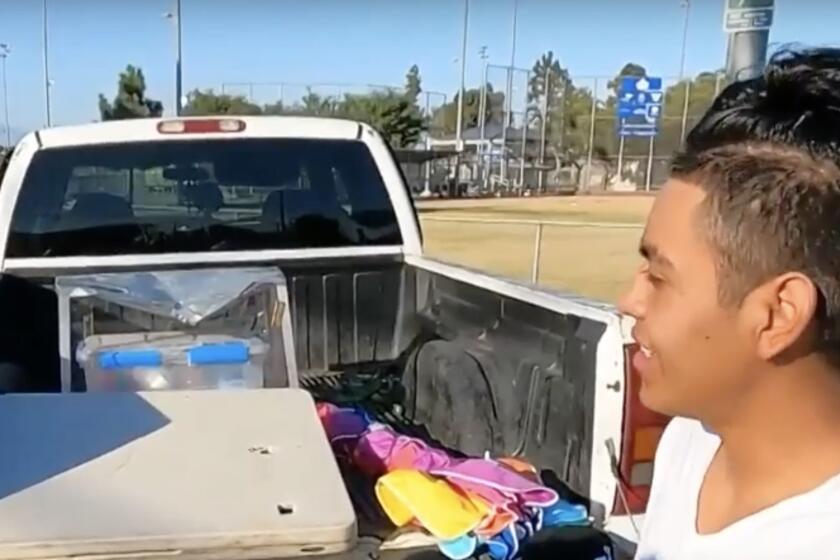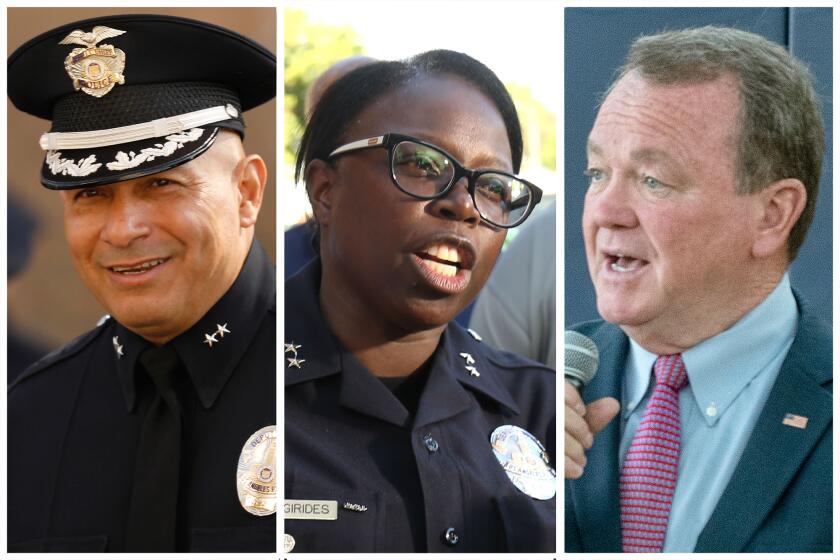Honoring the women who protect and serve
Watching Fanchon Blake make her way to the microphone, it was hard to envision the firebrand who helped remake the Los Angeles Police Department. Her gait was slow, her speech was halting, her bearing unlike that of the legendary policewoman old-timers recalled.
But to the luncheon crowd in the Police Academy gym — women wearing pearl earrings and police uniforms, carrying Gucci bags and holstered guns — the elderly woman had rock star status.
They cheered and applauded, then lined up to pose for photos with her. It was, after all, Blake’s 1973 lawsuit that ushered many of them into and up the ranks of the LAPD.
At my table near the back, Lt. Cindy Benes had to stretch to see her. Benes joined the force in 1980, one of a flood of female recruits hired as Blake’s discrimination suit pushed the department into a court-monitored consent decree.
Before Blake sued, women couldn’t be promoted beyond the rank of sergeant, were allowed to supervise only other women and had to be at least 5 feet, 6 inches tall.
Benes is 5 feet tall, a lieutenant in the tough Northeast Division, supervising 24 gang and narcotics officers, all but one of them men.
::
You can chronicle the department’s change in numbers: Thirty years ago, there were 178 women on the force, about 2% of the total deployment. Today, there are 1,884. One in five officers is female, more than half work street patrol, and 74 rank above sergeant, the ceiling when Fanchon Blake served.
The struggles accompanying that change are harder to track. There is pressure to prove your mettle and find your space; to counter resentment with competence, to acknowledge stereotypes but rise above them.
LAPD Chief Charlie Beck, whose daughter is an officer in a gang unit, acknowledged as much in his luncheon speech. “Women not only do at least as well as men in this job, they do it with an extra burden,” he said.
The officers I spoke with on Wednesday were matter-of-fact about the challenge.
“It was hard to feel like you fit in” when Benes joined 30 years ago, she said. “The department was like all white, male, 6-foot fall Vietnam vets. The big question for us was did we have the physical strength.”
She found a role where size didn’t seem to matter so much: working undercover with the vice unit. And over the years, the relaxed height restriction Blake’s lawsuit wrought has shaped a department “that’s gotten shorter … and more in sync with the community,” Benes said. “I stuck around long enough to fit.”
Until the 1970s, women were trained separately, wore skirts and heels and weren’t allowed in patrol cars.
“We knew they didn’t have the same training, and nobody wanted to be responsible for some female getting hurt,” retired detective Dallas Binger recalled.
“If you’re in a life-threatening situation, would you want a partner in high heels with her gun in a purse, or somebody who looks like her?” he asked, gesturing across our table at the diminutive Benes, in uniform with her gun in a holster.
After pants replaced skirts and women began working patrol, new resistance arose from an unexpected quarter: “We had the wives of officers calling stations saying ‘Don’t let my husband work with her,’ ” recalled Sandy Jo MacArthur, who spent 10 years in patrol because “I didn’t want anybody to say that I didn’t do my time.”
When she graduated from the Police Academy in 1980, women in patrol cars were so rare “it was hard to go to a restaurant and eat without everybody staring at you,” MacArthur said.
Today, if people stare, it’s because of the three bars pinned to her collar. Assistant Chief MacArthur is the highest-ranking woman on the LAPD.
::
Wednesday’s luncheon was sponsored by the Legendary Ladies, retired policewomen from Blake’s era. So there was lots of talk about firsts — the first female lieutenant, first commander, the first firearms instructor, first helicopter pilot.
But what struck me as I crisscrossed the room was how little gender seemed to matter.
When I asked why they joined the force, the women told me the same things I hear from men: They like the adventure and adrenaline rush, the paycheck and the pension plan, the community contact and chance to help. They were drawn by campus recruitment fliers, advice from neighbors, a conversation with a guy at the gym.
For some, police work was the family business. Gail Ryan is a fourth-generation Irish cop. She followed her dad into the LAPD in 1967 and stayed for 33 years.
For others, it was a long-shot. Joyce Kano was a housewife with an infant son. “My husband didn’t think I’d last. He was shocked when I made it,” she recalled. She was the LAPD’s first Asian American female. She joined in 1968, lasted 20 years and retired as a detective in Hollenbeck Division.
She used to carpool with Binger when both worked juvenile at the Georgia Street station. Kano had a desk job, taking calls from worried parents, while Binger patrolled the streets rescuing runaways from predators and pimps.
“Back in those days,” Binger said, “it was pretty rare to find policewomen anywhere working the streets.”
But “just being on the LAPD made us tougher,” Blake told the crowd. “Where we were coming from as women, we were quite naive. But we were not bashful.”
Blake left the department before her lawsuit was settled. She was ostracized after she filed suit, had a stroke and felt forced to retire. Her one regret? “I wanted to be chief of police,” she said.
At that, MacArthur took the chief’s stars from her uniform and pinned them to Blake’s jacket. The 89-year-old pioneer wept at the gesture. The assistant chief held her own tears back.
More to Read
Sign up for Essential California
The most important California stories and recommendations in your inbox every morning.
You may occasionally receive promotional content from the Los Angeles Times.










